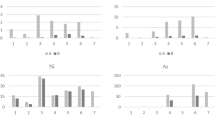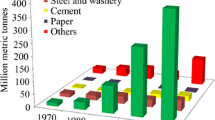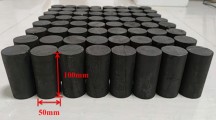Abstract
Possible chemical reaction schemes of the interaction of the organic matter of coal (OMC) with the decomposition products of sodium nitrite in the determination of the ignition temperatures of unoxidized (reduced), tested, and oxidized coals according to DSTU 7611:2014 “Coal: Method for the Determination of Oxidation and the Degree of Oxidation” were proposed. Studies on the determination of the ignition temperatures of 170 samples of unoxidized coals of various types from Ukraine, the Russian Federation, Canada, Australia, the Czech Republic, Poland, and Indonesia were carried out to evaluate the influence of the composition, structure, and properties of these coals on the ignition temperature. Close correlations of the ignition temperatures of unoxidized coals with the concentrations of organic (Cdaf) and aromatic (Car) carbon in them, the structural parameter δ characterizing the degree of unsaturation of the OMC structure, the vitrinite reflectance (R0), and the yield of volatiles (Vdaf) were established.





Similar content being viewed by others
REFERENCES
Veselovskii, V.S., Khimicheskaya priroda goryuchikh iskopaemykh (Chemical Nature of Fossil Fuels), Moscow: Akad. Nauk SSSR, 1955.
Nesterenko, L.L., Biryukov, Yu.V., and Lebedev, V.A., Osnovy khimii i fiziki goryuchikh iskopaemykh (Fundamentals of the Chemistry and Physics of Fossil Fuels), Kiev: Vishcha Shkola, 1987.
Roberts, J. and Caserio, M., Basic Principles of Organic Chemistry, New York: Benjamin/Cummings, 1964, vol. 2.
Carey, F.A. and Sundberg, R., Advanced Organic Chemistry, Part A: Structure and Mechanisms, New York: Plenum, 1977.
Laird, T., Quinones, in Comprehensive Organic Chemistry, Barton, D. and Ollis, W.D., Eds., Oxford: Pergamon, 1979, vol. 1, p. 1213.
Glushchenko, I.M., Teoreticheskie osnovy tekhnologii goryuchikh iskopaemykh (Theoretical Basis of the Technology of Fossil Fuels), Moscow: Metallurgiya, 1990.
Kucher, R.V., Butuzova, L.F., and Kompanets, V.A., Struktura iskopaemykh uglei i ikh sposobnost' k okisleniyu (The Structure of Fossil Coals and Their Ability to Oxidation), Kiev: Naukova Dumka, 1980.
Butuzova, L., Krzton, A., Saranchuk, V., et al., Fuel, 1994, vol. 73, p. 945.
Butakova, V.I., Popova, V.K., Posokhov, Yu.M., and Kuznetsova, N.P., Coke Chem., 2013, vol. 56, no. 7, p. 225. https://doi.org/10.3103/S1068364X13070028
Tronov, B.V., Izv. Tomsk. Industr.Inst., 1940, vol. 60, no. 3, p. 11.
Tronov, B.V., Zh. Prikl. Khim., 1940, vol. 13, no. 7, p. 18.
Davies, D. and Parrot, M., Free Radicals in Organic Synthesis, Heidelberg: Springer, 1978.
Saranchuk, V.I., Oshovskii, V.V., and Vlasov, G.A., Fiziko-khimicheskie osnovy pererabotki goryuchikh iskopaemykh (Physicochemical Fundamentals of the Processing of Fossil Fuels), DonGTU, 2001.
Ulanovskii, M.L., Coke Chem., 2012, vol. 55, no. 7, p. 256. https://doi.org/10.3103/S1068364X12070095
Saranchuk, V.I., Ruschev, D., and Semenenko, V.K., Okislenie i samovozgoranie tverdogo topliva (Solid Fuel Oxidation and Spontaneous Ignition), Kiev: Naukova Dumka, 1994.
Rosema, H. and Guan, H., Fuel, 2001, vol. 80, p. 7.
Kuzin, N.A., Adsorbtsiya i Adsorbenty, 1974, no. 2, p. 10.
Neiland, O.Ya., Organicheskaya khimiya (Organic Chemistry), Moscow: Vysshaya Shkola, 1990.
Korol'chenko, A.Ya. and Korol’chenko, A.A., Pozharo-vzryvoopasnost' veshchestv i materialov i sredstva ikh tusheniya (Fire and Explosion Hazard of Substances and Materials and Extinguishing Agents), Moscow: Pozhnauka, 2004, vol. 1.
Golovko, M.B., Drozdnik, I.D., Miroshnichenko, D.V., and Kaftan, Yu.S., Coke Chem., 2012, vol. 55, no. 6, p. 204. doi Koks Khim., 2012, no. 6, p. 9.https://doi.org/10.3103/S1068364X12060038
Miroshnichenko, D.V. and Golovko, M.B., Coke Chem., 2014, vol. 57, no. 3, p. 117. doi Koks Khim., 2014, no. 3, p. 32.https://doi.org/10.3103/S1068364X14030041
Miroshnichenko, D.V., Koks Khim., 2003, no. 4, p. 3.
Rumshinskii, L.Z., Matematicheskaya obrabotka rezul’tatov eksperimenta: spravochnoe posobie (Mathematical Processing of Experimental Results: A Reference Guide), Moscow: Nauka, 1971.
Author information
Authors and Affiliations
Corresponding authors
Additional information
Translated by V. Makhlyarchuk
About this article
Cite this article
Miroshnichenko, D.V., Nazarov, V.N. & Nikolaichuk, Y.V. Influence of an Oxidant on the Ignition of Coals. Solid Fuel Chem. 54, 318–325 (2020). https://doi.org/10.3103/S0361521920020093
Received:
Revised:
Accepted:
Published:
Issue Date:
DOI: https://doi.org/10.3103/S0361521920020093




